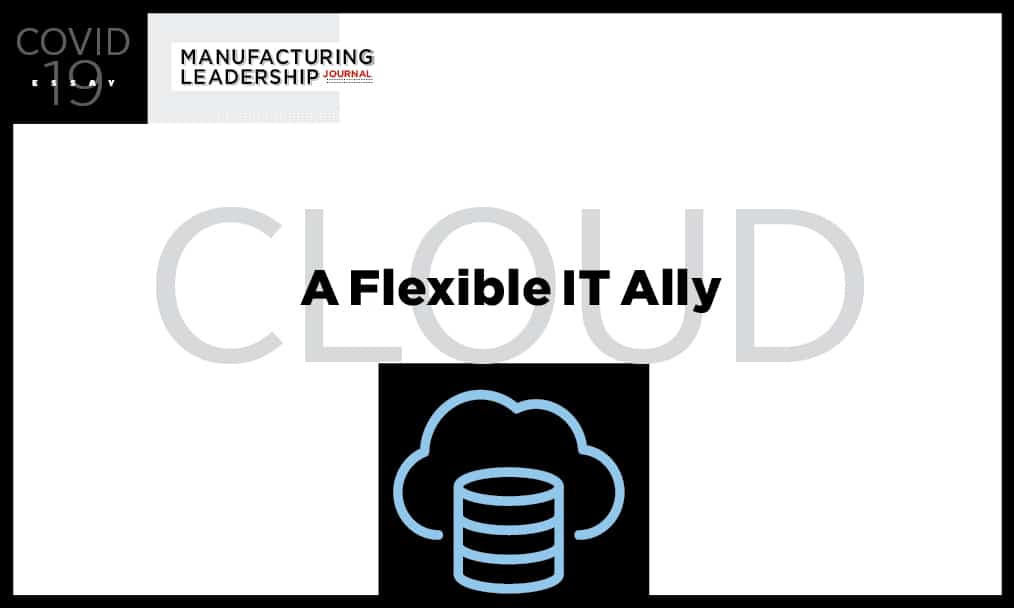
Will cloud adoption accelerate as a result of COVID-19?
For manufacturers, the cloud can be a source of flexibility, scalability, cost savings, and more – all things vital to business continuity during the COVID-19 crisis.
As a result of the pandemic, some manufacturers may accelerate their cloud strategies, putting more systems in the cloud, faster. Others are simply validating the confidence they’ve placed in the cloud strategies they’ve already adopted and will likely continue with the same approach.
But there’s no doubt companies are seeing real evidence that the cloud is an asset that needs to be prioritized, says Kevin Prouty, Group Vice President at IDC Manufacturing Insights.
“Everyone already realizes we wouldn’t be operating if we didn’t have systems in the cloud,” Prouty says. “We’re at a point where we’re actually taking cloud applications for granted, like the telephone. If we start to look at the cloud as critical business infrastructure, that’s the sea change we need because post-COVID, the default for manufacturing companies will be the cloud.”
An IDC report, “Manufacturing Resiliency in the Age of COVID-19,” found that cloud and digital collaboration were critical to business continuity, especially as workforces moved to remote modes of operation.
“Like any business, manufacturing company employees, whether executives or plant management, need to stay connected — to keep the business moving forward and to maintain a sense of normalcy and community,” the report says. “Providing digital conferencing tools and shifting to a digital way of collaborating, communicating, and learning that is typical for executive management needs to also be available to the rest of the organization.”
Facilitating Remote Work
The cloud facilitates the flexibility, rapid decision-making, and digital collaboration needed to support the pivot to work-at-home arrangements. Gary Cantrell, CIO at manufacturing solutions provider Jabil, said cloud systems allowed employees to start working from home immediately and has enabled them to sustain productivity and engagement.
The company has about 40% of its core applications in the cloud, with the goal of 80% over the next few years. Cantrell says Jabil has a cloud-first methodology and the pandemic has “certainly validated both our need for, and use of, the cloud for critical systems.”
In the future, Cantrell believes manufacturers will accelerate their cloud adoption. “The industry was already moving in this direction and the variation in business seen during this pandemic will reinforce the need to have a higher level of agility, scalability (both up and down), and the best cost controls,” he says.
Similarly, with the help of the cloud, printer manufacturer Lexmark executed its global business continuity plan in just two days, shifting from few employees working at home to 94% (with some plants still open), without impacting the latency and performance of its systems. The company has all its systems in the cloud, with about two-thirds in the public cloud and one-third in a private cloud.

“If we start to look at the cloud as critical business infrastructure … post-COVID, the default for manufacturing companies will be the cloud.”
CIO Brad Clay says Lexmark hit its first quarter goals, even as 9,000 employees across Latin America, Europe, the U.S. and other regions transitioned to remote work.
“[The pandemic] gave us the opportunity to leverage our [cloud] tools in a very rapid fashion,” he says. “We had really good use of the tools previously but weren’t taking them to the full capacity they were designed for, but this forced us to do that in the course of a week and it’s been pretty awesome to watch.”
When COVID-19 hit, Owens Corning went from five percent of its employee base working at home to 100% in two to three weeks. Cloud and digital tools have allowed them stay on top of the health and safety of the workforce as the crisis continued.
The company sends a daily survey via text message to employees asking them about their well-being and any possible exposure. The results populate into a visual dashboard showing the overall health of the workforce, which helps them better manage safety across physical facilities.
Many of Owens Corning’s systems are in the cloud and they operate under a ‘why not cloud’ strategy. But core systems such as its ERP system are still on-premise and that won’t change “until we get to a logical end-of-life period,” says CIO Steve Zerby.
He doesn’t expect that companies that are performing well with a combination of on-premise and cloud will shift investments to cloud-only immediately.
“I don’t think this has been a period of time where the cloud has enamored itself to a lot of enterprise technology folks,” Zerby says. “But the pandemic is going to make sure that people actually have a plan. ‘Do you have a plan to connect your company, whether it be on-premise or in the cloud?’ If you have to fill those gaps quickly, that’s where most of the real [benefits] are today.”
IDC “expects the key strategic initiatives of digitally connected platforms, integration of IT/OT, and embedding cognitive technologies across these systems will remain for manufacturers…They are critical to ensure the long-term viability and flexibility of these organizations.”
For manufacturing leaders, the cloud has, in many cases, proven to be an ally in helping to meet the need for flexibility. Looking ahead, one can only anticipate that the dependency will grow. M